Zinnias are perennial plants that grow up to 3 feet tall. They have long, slender stems and showy, colorful flowers ranging from yellow to white or pink. These plants can be grown from seed or purchased as an already-grown plants. Zinnias are easy to grow, requiring little care other than regular watering. Zinnias are a great option if you’re looking for an easy way to add some summer color to your garden. These flowers grow quickly from seed and are relatively maintenance-free. They will reward you with large, brightly colored flowers.
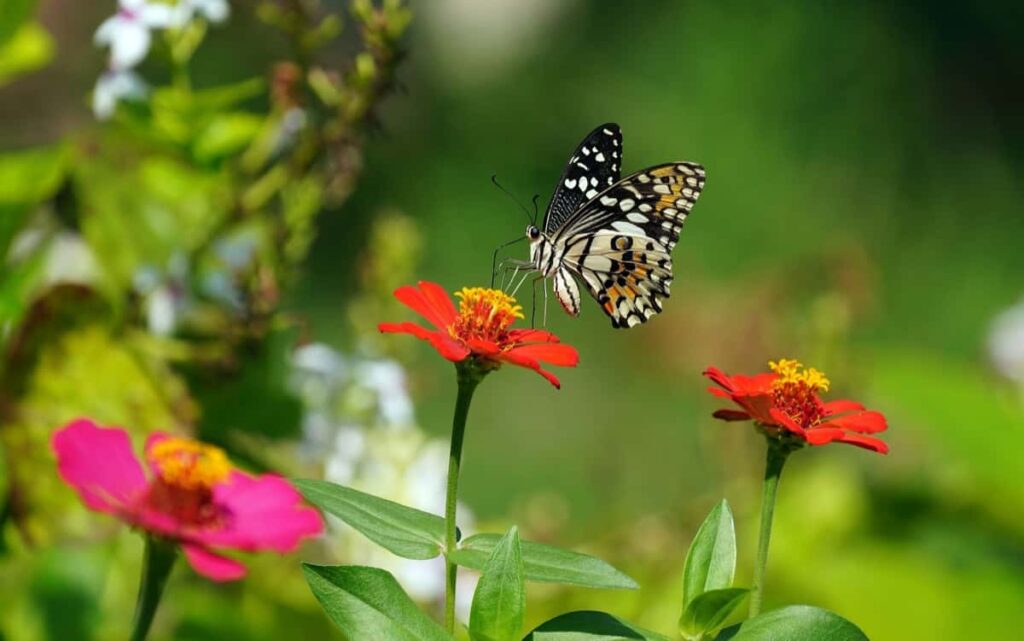
How to grow Zinnias from seed
How long does it take to grow Zinnia from seed?
Growing Zinnias from seed is a relatively easy task that can be completed in just a few weeks. Once the seeds have germinated, care should be taken to give them the proper water and sunlight. Once they reach a transplantable size, carefully remove them from their containers and place them in a prepared garden area. Watch for pests and problems and take care of them as needed. Zinnias will reach maturity after 2 to 3 months and produce flowers for around six weeks.
Harvesting seeds from Zinnias
- You can harvest seeds from Zinnias. Zinnias will self-pollinate and produce seed pods throughout the summer. Once the pods mature, you can collect and plant the seeds. Remove the seeds from the flower and place them in a jar or container. You can sow the seeds in early spring and expect to see blooms by late summer.
- To regrow Zinnias from seed, first, remove the spent flowers. This can be done by cutting off the stem at the base of the flower. If growing Zinnias in containers, snip off any spent flowers as they appear.
Where do I cut Zinnias for regrowth?
Zinnias are a tough annual garden plant that can withstand neglect. Begin by planting the seeds in early spring, when the ground is still cool and moist. Sprinkle them over the growing medium’s surface. Keep the area lightly moist and wait until they sprout before adding more water.
In case you missed it: Growing Zinnia Flowers Indoors from Seed, and Cuttings
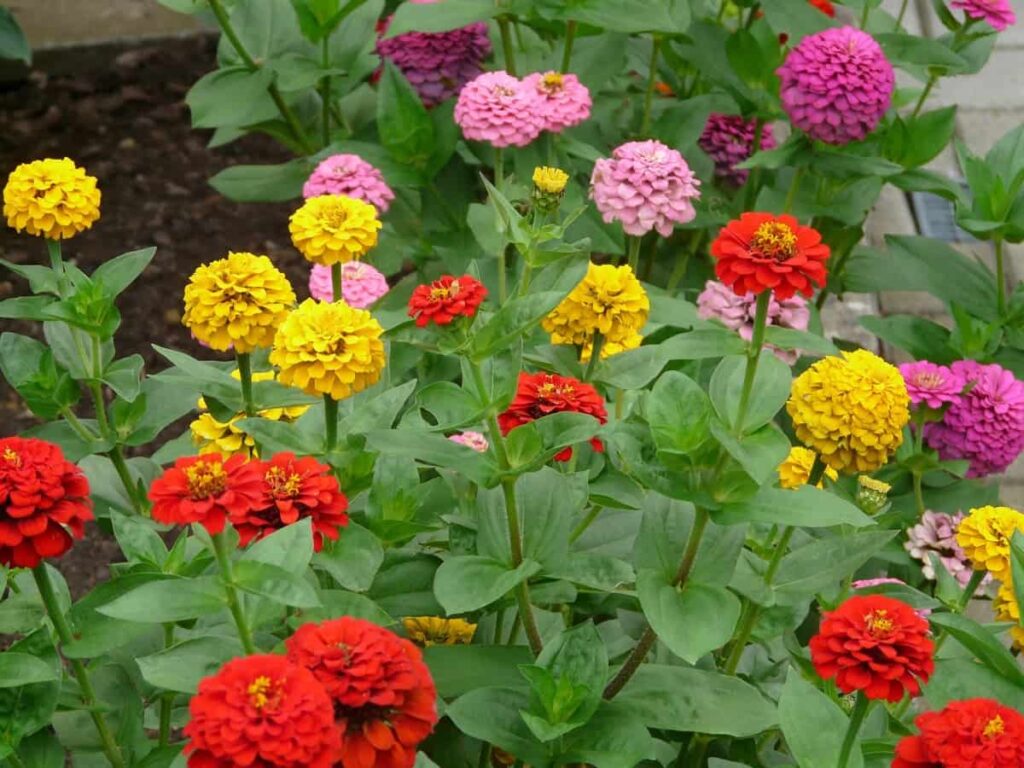
When they are 2 to 3 inches tall, thin the plants to 12 inches apart, water regularly, and fertilize with a balanced fertilizer every other week during growth. Zinnias bloom for about six weeks, after which you can cut them down to about 1 foot tall to encourage new regrowth.
Sun requirement for growing Zinnias
Zinnias are typically grown in full sun, but they can also tolerate some shade. They prefer moist soil but will do well in moderate to dry conditions. Zinnias are hardy in most climates and can be started from seed indoors six to seven weeks before the last frost and transplanted outdoors when the soil is warm. Zinnias need to be fertilized regularly with a balanced fertilizer. Water them well during their growing phase, and keep the soil moist but not soggy.
Why are my Zinnias so leggy?
There are many types of Zinnias, each with unique beauty and characteristics. Some Zinnias grow quickly and have long, leggy stems, while others grow more slowly and have shorter stems. Make sure to water your plants regularly and give them a good fertilizer if they’re growing slower than you would like.
Zinnias need lots of nitrogen to grow well, but too much nitrogen can cause your plants to grow excessively leggy. Try using a lower dose of nitrogen when fertilizing your Zinnias in the future. If you’re growing your Zinnias in an environment that isn’t optimal (too hot or too cold, for example), their growth could be stunted due to a lack of nutrients or light.
In case you missed it: 25 Flowers for Container Gardening: Top Best List and Easy for Beginners
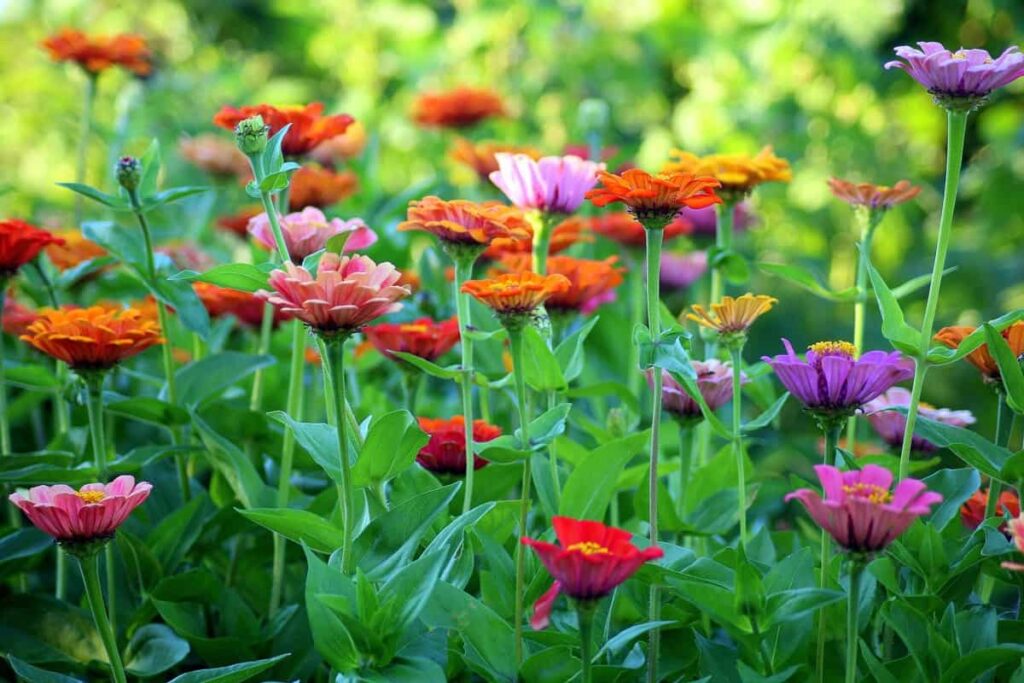
The best month to plant Zinnias
Zinnias are a cool-season crop and can be planted in many different months. When growing Zinnias, the best time is during the early spring season. However, they can also be planted during the fall or early winter. You should wet the soil before planting the seeds, then water them regularly until germination occurs. Once the Zinnias have germinated, you must water them regularly until they reach their desired size.
Water requirement for growing Zinnias
Zinnias are flowers that like lots of water. It is essential to keep the soil moist but not overwater the plants. They will appreciate occasional misting with a spray bottle. You can also try using a soaker hose to distribute water evenly around the plants. You can water Zinnias daily if you live in an area with a warm climate. If you live in cooler weather, you may only need to water them once per week. Remember to water the leaves, not the stem. You can water them daily if you want, or give them a light watering once a week.
Fertilizer requirement for growing Zinnias
Zinnias are easy to grow from seed but do require fertilizer to thrive. During the growing season, fertilize every two weeks with a high-nitrogen fertilizer, such as 10-10-10 or 14-14-14. When growing Zinnias from seed, one important thing to remember is to use a good fertilizer. Many different types of fertilizers are available, and it is essential to choose one that will suit the needs of your Zinnia plants.
Some common fertilizers used for Zinnias include liquid nitrogen, blood meal, urea, and ammonium sulfate. Choosing the correct fertilizer for your Zinnia plants is essential based on their specific needs. Research which fertilizers are best suited for your area, and make sure you apply them according to the directions on the product label.
In case you missed it: Top 10 All Year Flowering Plants
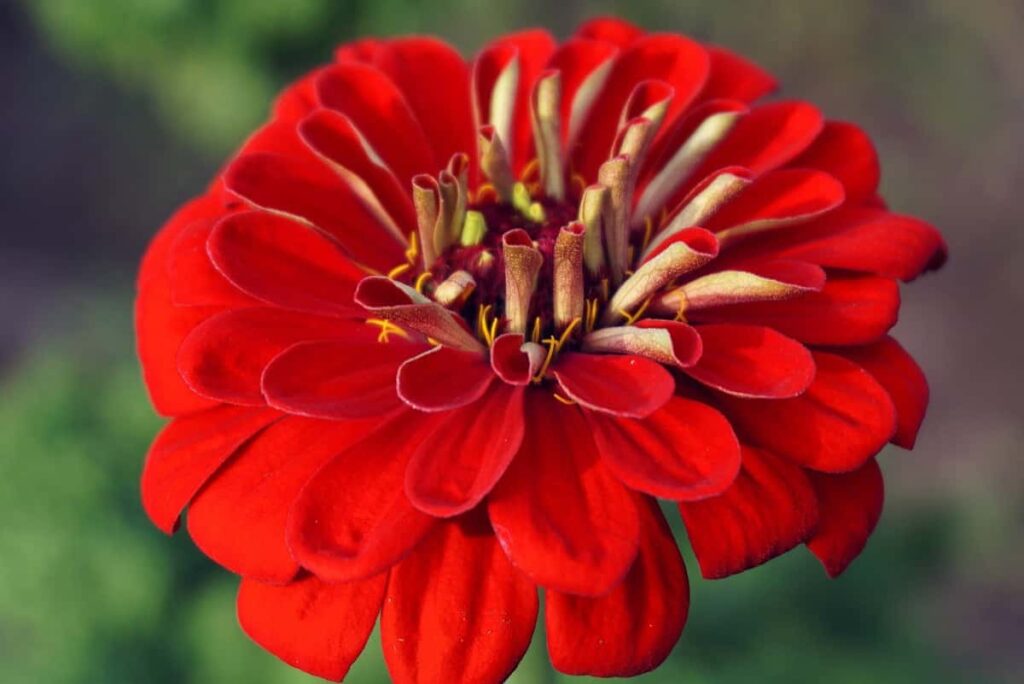
Why are my Zinnias floppy?
Zinnias are a type of flower that many gardeners enjoy growing from seed. However, some Zinnias may be floppy due to improper watering or fertilization. Start your seedlings in a bed of organic soil amended with compost and well-rotted manure. Remove the larger plants after they have grown six inches tall to allow the remaining plants to grow more densely.
Water your plants regularly, keeping in mind that water should not get pooling on the ground below the plants. Instead, aim to water Zinnias evenly throughout their root zone. Feed your Zinnias a balanced fertilizer every two weeks during their first year of growth. Use a formula low in nitrogen and phosphorus, as these nutrients will cause foliage to grow on the plant instead of flowering.
What is the life cycle of a Zinnia?
Zinnias are the easiest plants to grow from seed, producing abundant flowers in early summer. There are several steps in the life cycle of a Zinnia. First, you must sow the seeds in late winter or early spring. Second, for about six weeks, your Zinnias will need to be grown in warm weather, between 15 to 26°C. Third, when the flowers start to fade away, you should cut them down and enjoy the vibrant greens on the plant.
Finally, dispose of any spent flowers by throwing them away or composting them. Zinnias are versatile flowers that can be grown from seed. Zinnias have three growth stages: early, maturation, and flowers. Early Zinnias have smaller leaves and lack petals. Maturation Zinnias have larger leaves and petals. Flowers are in the final stage of Zinnia growth, and they will bloom with colorful petals.
When to sow Zinnia seeds in India
To germinate Zinnia seeds, you will need a warm, temperate climate and plenty of light. The best time to sow them in India is in early spring, around March or April. Ensure the soil is well-drained and amended with compost before sowing your seeds; water them thoroughly once they’ve germinated. Once they’re growing, thin out the plants to 12 inches apart.
Do Zinnia seeds need to dry before planting?
If you choose to plant Zinnias from seed, ensure they are completely dry before you sow them. Gently shake the seeds out of the pod and let them rest on a paper towel for about 24 hours. You can then sprinkle the seeds on top of your desired growing medium and press down firmly with a finger to ensure they’re well coated. Water regularly, but make sure the soil is always moist but not wet. If you live in a hot climate, you may want to water once a week instead of daily.
How deep do you plant Zinnia seeds?
Zinnias are a great way to add bright, colorful flowers to your garden. Zinnias grow best when you plant them directly in the ground, but you can also sow them into a container and then transplant them when they are ready to grow.
Zinnias will grow best in moist soil, so water them regularly. You can plant Zinnia seeds anywhere from late winter through early spring. When planting Zinnia seeds, you should sow them an average of 1/4 inch deep. After sowing the seeds, lightly cover them with soil and pat them down.
In case you missed it: How to Create a Beautiful Flower Garden in the Balcony

The best soil for growing Zinnia
When choosing the best soil for growing Zinnias, the type of soil, pH level, and fertility are all important. To begin with, it is essential to know what type of soil your Zinnias will be planted in. Many people prefer potting soils because they are lightweight and easy to move around. However, peat moss or compost can also be used as a substitute for potting soil.
For Zinnias, a good starting point is two parts peat moss or compost to 1-part general planting mix. Next, it is essential to determine the pH level of the soil your Zinnias will be planted in. If you want to grow annuals that bloom throughout the year, like Zinnias, then aim for slightly acidic soil with a pH of 5.7 to 6.3.
Growing Zinnias in Pots from seed
Zinnias are a great addition to any garden and are especially easy to grow in pots. Zinnia is a perennial flower that grows best in full sun but will tolerate partial shade. Choose a pot that is the right size for the Zinnia flowers. Make sure the pot has plenty of room for the roots and enough depth, so the water doesn’t come up to the surface.
Plant Zinnias seeds in a well-drained soil mix. Add some compost or organic matter if necessary. Water Zinnias regularly but sparingly during dry spells, only enough to keep the roots moist, not so much that the soil becomes soggy. Fertilize Zinnias every few weeks with a diluted fish emulsion before really taking off, then stop when new growth begins to wilt (this will depend on variety).
Zinnias care in winter
Zinnias will not require as much water in the winter, but remember to water them regularly. Water Zinnias once a week during the winter if you can. Let the soil dry out between waterings. First, ensure they are well watered to protect Zinnias from frost over the plants with a layer of straw to keep them warm and moist.
Finally, wait until the ground thaws before removing the protective layer. In the winter, when many plants are not getting sunlight, it is essential to fertilize them to maintain their health and vigor. Fertilizers can come in several forms, including soluble and insoluble granules, blood meal, fishmeal, and manures.
In case you missed it: 16 Fragrant Spring-flowering Shrubs: How to Grow, Planting, and Care
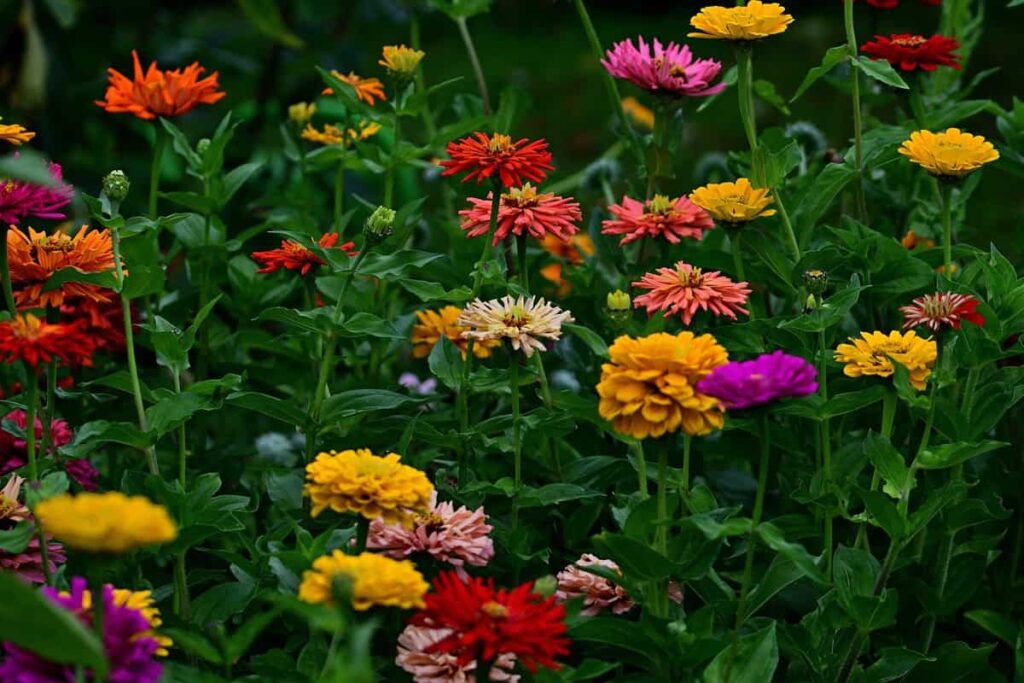
Germinating Zinnias seeds indoors
If you want to germinate Zinnia seeds indoors, fill a tray with fresh potting soil and add the desired number of seeds. Wet the soil around the seeds with your finger, then smooth out the surface of the soil. Sprinkle a light layer of sand on top of the soil and spread it evenly across the surface. Place your seed on top of this layer of sand, ensuring they are positioned so that their tops are submerged in the soil, but their bottoms are exposed. Water your Zinnia seeds regularly and moisten them until they germinate (about two weeks).
Conclusion
Zinnias are one of the easiest flowers to grow and attract attention in your garden. They come in various colors, from bright oranges and reds to soft pinks and whites. For any gardener, Zinnias are one of the most popular flowers to grow. These cheerful colors and pleasing shapes are easy to cultivate from seed and usually take about two weeks to germinate. With some preparation, you can grow Zinnias from seed and enjoy their natural beauty all year.
- How to Grow Hibiscus from Flower
- Plantation Ideas for Home Decoration: A Beginners Guide
- Flower Garden Designs and Layouts for Beginners
- Planting and Spacing Techniques in Papaya: A Beginner’s Guide
- Growing Gold: Essential Techniques for Planting Pineapples
- How to Make Kalanchoe Plant Bushy: Home Remedies and Solutions
- 11 Reasons Why Your Gardenia is Not Blooming: Home Remedies and Solutions
- Eco Elegance: The Guide to Designing a Drought-Tolerant Landscape
- Gardening on a Slope: Strategies for Hillside Landscaping
- Nourish and Flourish: Top Organic Mulches for Thriving House Plants
- Everything You Want to Know about Indian Mogra Flower: Discover Uses and Growing
- Green Thumb Success: Expert Tips for Cultivating Greenhouse Pumpkins All Year Round
- Maximize Growth & Flavor: The Ultimate Guide to Companion Planting in Herb Gardens
- How to Control Rhododendron Problems Naturally: Home Remedies and Organic Ways to Fix Them
- Natural Magic: The Remarkable Benefits of Cinnamon for Plants
- Best Steps to Revive Dying Tulip with Natural and Organic Treatment
- 10 Reasons Why Your Angel Trumpet is Not Blooming: Remedies and Treatment
- How to Fix Periwinkle Leaf and Flower-Related Problems: Natural Remedies and Solutions
- How to Fix Zinnias Leaf and Flower Problems: Discover Natural and Home Remedies
- Organic Steps to Induce Lemon Tree Flowers: A Comprehensive Guide
- Bloom Booster: Crafting the Perfect Homemade Bougainvillea Fertilizer
- Optimizing Growth: A Guide to Applying NPK Fertilizer for Potted Plants
- 10 Best Homemade Fertilizers for Rubber Plant: DIY Recipes and Application Method
- How to Boost Female Pumpkin Flowers: Effective Steps for More Flowers and High Yields
- Transform Your Indoor Garden: Top Benefits of Pink Salt for Houseplants
- 10 Best Homemade Fertilizers for Peacock Plants (Calathea): Easy DIY Guide
- Unlock Blooms: 9 Reasons Why Your Potted Chrysanthemum is Not Blooming
- 8 Reasons Why Your Potted Hibiscus is Not Blooming: Fix it with Simple Solutions
- Unlock Blooms: 9 Key Reasons Your Potted Frangipani Won’t Flower
- 10 Reasons Why Is My Ice Plant Not Blooming: Remedies and Treatment
- 10 Reasons Why My Potted Hydrangea Not Blooming: Treatment and Remedies
- 10 Reasons Why is My Wisteria Not Blooming: Remedies and Treatment
- 10 Reasons Why is My Goldfish Plant Not Blooming: Remedies and Treatment
- Maximize Your Space: Ultimate Guide to Balcony Gardening with Grow Bags
- 10 Reasons Why Your Iris is Not Blooming: Remedies and Treatment
- 10 Reasons Why Your Anthurium Plant is Not Blooming: Treatment and Remedies